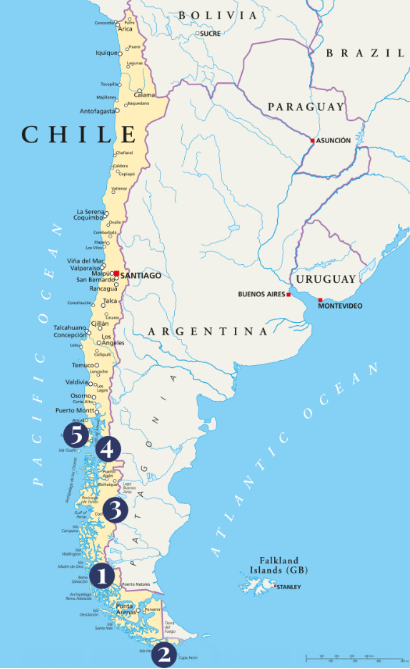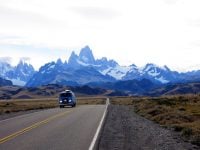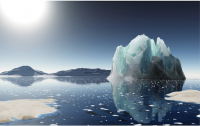An area that encompasses the southern regions of Chile and Argentina, Patagonia covers over 260,000-sq. miles (673,000-sq. km). It is for this reason that it’s difficult to see all of the ten highlights on this list in one holiday. Depending upon the length of your vacation, it’s wise to concentrate on one region or plan to take a number of long distance flights or bus journeys to help you cover the necessary distances.

1) Torres del Paine National Park, Magallanes Region
A trip to Patagonia is lacking without a visit to the world-renowned Torres del Paine National Park. The main attractions are the ‘W’ and Circuit hikes: two trekking routes which explore the barren, snow-capped mountains and glacial-fed lakes of this region.
Named in 2013 by National Geographic as the fifth most beautiful place in the world, it’s accessible from Puerto Natales, the main city in this part of Patagonia. Accommodations can be booked online and range from serviced campgrounds to luxurious hotel rooms.
2) Cape Horn, Magallanes Region
For years, the passageway around Cape Horn was the only navigable route between the Pacific and Atlantic Oceans and came to be known as the “Ends of the Earth”. An estimated 800 ships and over 10,000 sailors were lost here between the 16th and 20th centuries; a sad part of the region’s history that is now commemorated by the Cape Horn Monument built on the island in 1992.
These days, the passage to Hornos Island remains stormy and the gale force winds that are known as the “furious fifties” and “screaming sixties” make a trip here a complete adventure – but that’s all part of the appeal. Visitors can step ashore and visit the sole lodgings on the island – a lighthouse staffed by a member of the Chilean navy and his family – on what remains a barren yet captivating symbol of Patagonian and international history.
3) Patagonia Park, Aisén Region
Patagonia Park is a recently opened park established by the Tompkins Conservation group. An area dedicated to protecting the Patagonian steppe, rugged mountains and its endemic, rare and endangered species of wildlife, it has various activities for those seeking a few days of adventure in the secluded Patagonian countryside.
Hikes pass through wild landscapes to arrive at turquoise river waters or to reach viewpoints for admiring Lago Cochrane and Mt. San Lorenzo – two of the many landmarks in the park. With an incredible diversity of ecosystems, over 100 different species of birds have been spotted here, making it an excellent location for bird and wildlife watching. Visitors can arrange fly fishing and mountain biking, while a variety of comfortable accommodations providing lodging.
4) The Carretera Austral, Los Lagos/Aisén Region
The Carretera Austral (also known as Ruta 7), passes from Puerto Montt in the north of Patagonia to Villa O’Higgins in the south of the Aisén Region. Encountering a number of small, picturesque villages and conical volcanoes along the way, this drive is probably the most scenic in all of Patagonia.
Highlights include the hot springs at Puyuhuapi and the spectacular Hanging Glacier in nearby Queulat National Park. Further south, the San Rafael Lagoon and Glacier demand a visit, particularly given the fact that the latter is receding at a worryingly rapid pace. Lago General Carrera and the Marble Cathedral at Río Tranquilo also attract thousands of visitors per year; motorboat tours take tourists around the lake to admire the rich stripes of colour that run through the marble of which this cave complex is composed.
5) Chiloé Island, Los Lagos Region
Chile’s second largest island, Chiloé is an archipelago located a short ferry ride from Puerto Montt. This island combines history and access to nature along with a distinctive culture that separates it from mainland Chile. One of the most enduring features of Chiloé’s unique character is visible in the 16 unique UNESCO World Heritage recognized wooden churches that are scattered across the main island and the various islets that make up Chiloé. In the north, Chiloé also puts visitors in close contact with wildlife at the Puñihuil penguin colony, which is a shared breeding site for Humboldt and Magellanic penguins and visitable by Zodiac boat.
Overlooking the bay at Castro, one of the island’s main towns, tourists can photograph the traditional fishermen dwellings called palafitos which are built on stilts and remain one of the most colorful and symbolic landmarks here. The island’s food also expresses Chiloé’s exciting cultural history. Visitors are recommended to try the local dish, curanto, whose ingredients include shellfish, meat, potatoes and vegetables, and which is slow-cooked using the Polynesian method of placing hot rocks in an earthen pit.
No comments yet
There are no comments on this post yet.






Leave a comment